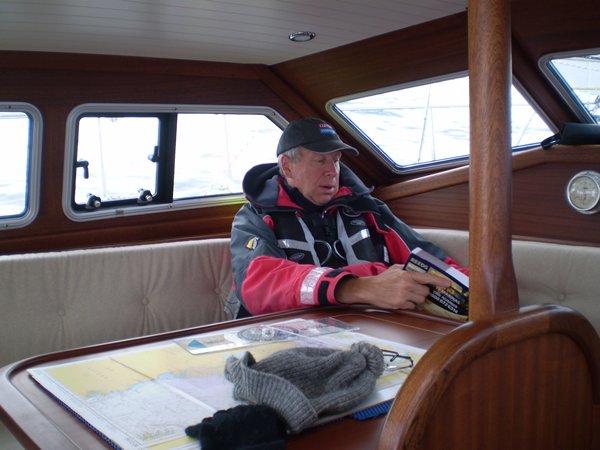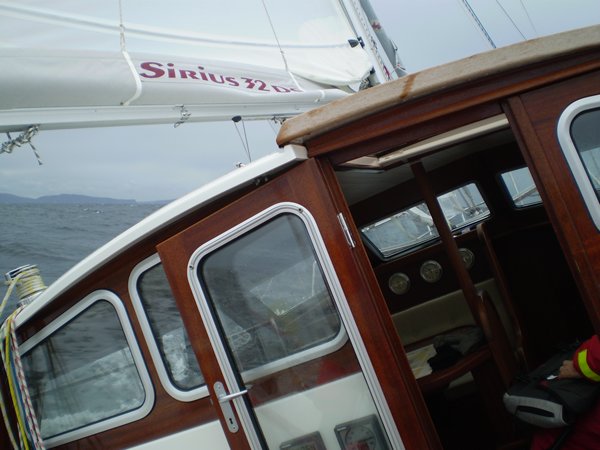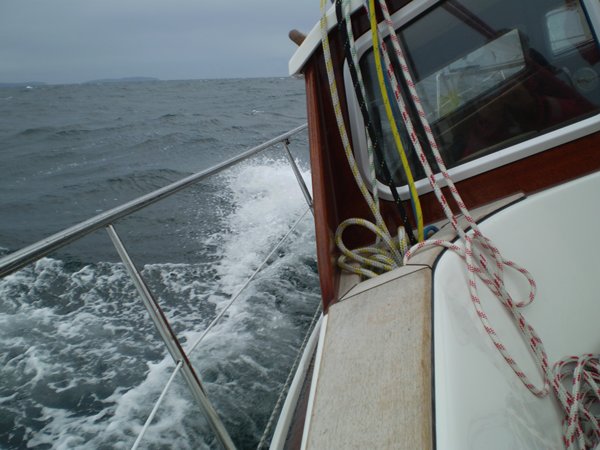The homerun

Moondog
Brian Whitefoot
Fri 17 Sep 2010 19:56
My crew for this last section was to be Paul, who had crewed the first leg from Neustadt to Dragor in Denmark in late May / early June ; a nice symmetry! This time we were heading for Moondog's home port of Deganwy Quays, near Conwy in North Wales ( 53:17.45N, 003:49.65W).
We finally decided to return to Troon on Thursday 16th September, and initially planned to set sail early on the 17th, to catch the tides. Although the tides were not a big issue down the coast for the first leg to Corsewall Point, we had to get there at the right time to catch the south flowing tide in the North Channel, which would then push us down towards the Isle Of Man. Getting this wrong would greatly extend the journey time and risk wind against tide in the North Channel, which would not be pretty, particularly after the recent strong NW gales. We also had to arrive at the Conwy river entrance ideally within 2 hours either side of HW, in order to cross the bar and get into the marina up river before it closed its sill ( a type of gate that lifts from the seabed to keep water in the marina as the tide drops). We could only achieve this if we had the tide with us down the N Channel. We would then effectively miss most of the adverse tide later by passing in the 'tidal lee' of the Isle of Man, and then just having a mild cross tide as we did the final stretch to Conwy.
As will be clear from the above, we had decided to do the trip in one leg, non stop, of approximately 170 miles or so. The main reason for this was that it was becoming clear that we were now firmly in the autumnal weather, and it looked like we would have a day or two of reasonable winds , but after that it could turn nasty again. Make hay while the sun shines as they say.
A quick look outside at around 5.30 am on Friday was all we needed to see that we were going nowhere that morning, so a lazy day beckoned. However, the forecasts still were predicting falling winds ( although not to the extent of the previous day's forecast ), and a good wind direction at least for the first part of the trip down to the North Channel. We cross checked this on various weather web sites as well as the met office forecast, and it all more or less agreed. So, in order to hit all those tidal 'gates' it meant a departure from Troon at 7pm . We were comfortable night sailing down the Scottish coast, but not over joyed at having to do our approach into Conwy at night, at or near HW Conwy at approximately 9pm the following day. However, if we delayed again we could miss the weather window entirely, so we got a few hours rest, a decent meal and then cast off at 7pm.
Out of the harbour entrance and it was immediately clear that we still had a big swell left over from the gales,as we took green water over the foredeck and onto the cabin roof. We plugged on and, as is often the case, as soon as we got out into deeper water things settled down a bit so we decided to continue. Navigation was simple ; track the coast , staying a few miles off in safe and deep water, and pass inside of the steep little island of Ailsa Craig. As night fell, the wind held as a strong F4, gusting 5, from the NW. This was perfect for reaching SSW down the coast, and we made Corsewell Point around 2am, and were averaging around 6 to 6.5 kts over the ground, with a fairly lumpy sea that was tossing us around a bit and wasting a bit of speed. We were on schedule, and in fact even a little ahead.
It was on this leg that we had a minor drama, when ( as we learnt later ) a rubber seal on the domestic hot water tank failed, and the water pump pushed all of our fresh water from the main tank, through the faulty seal, into the bilges under the owners cabin and cockpit. This was a genuine unpredictable failure, and the seal itself is just a few pounds to replace. We were still getting our sea legs, and so bailing out this mess was not high on our wish list. Fortunately, most of the water was shifted with the bilge pump, but there was still about an hour of manual bailing out with a sponge and bucket from underneath the owners cabin bunk, until we were dry. The pitching of the boat in the seaway of course was causing the water to slosh from side to side, compounding the problem. My main concern had been to get rid of the water before it shorted out the electrics, but we had no problem in that regard.
Having got the boat dry, we also had no drinking water in the tank, which was now empty. Fortunately we had several big bottles of ( fizzy) mineral water, together with the water in our emergency kit, so were able to continue. A learning point from all of this was to be sure to always turn the water pump off on passage, and only switch it on when actually using a tap. This will ensure that the pump can never run and push water through a leaking seal or joint unnoticed.
As we were about to turn south into the North Channel ( yes, it is possible to go south in the North Channel ),we had a little dance with a big ship, describing itself as a dredger on the AIS, and lit up like a city centre. It must have had nav lights etc, but they were impossible to see against the blinding mess of all its other lights. The AIS showed it to be heading towards Scotland, but it was difficult to trust this, and impossible to make out bow vs stern ; it was just a blaze of lights. I realised I was getting disorientated, so stopped and circled on the spot , well away whilst trying to confirm its direction. At this point, someone on the vessel helpfully shone the world's brightest searchlight straight at us, so now we could see absolutely nothing. Then a VHF ch 16 message for us to keep at least 1 mile off and pass well astern, since she was towing a submersible. Quick call to them on the vhf to confirm they were indeed heading towards Scotland, and we were then clear where 'astern' was and passed them safely, as our night vision returned.
After this it was a quick sail down the North Channel with the tide. We were also lucky with the wind, which backed a little towards the west, on its way to the ultimately forecast SW, but for now we were still able to reach in a continuing F4. We were often making 7 kts over the ground, and were abeam the Mull of Galloway at dawn, heading towards the Isle of Man, which we reached a few hours later. It was an uneventful sail down the west coast of the Isle of Man, in a F4/5, still on the beam and making around 6 to 6.5 kts over ground in more or less no tide.
It was 1.30pm when we cleared Chicken Rock at the south tip of the Isle of Man, and it was just a case of sailing as close as we could to the wind as it continued to back slowly towards the SW, for the last 60 miles or so to Conwy...or so we thought. We were ready to motor sail whenever needed to maintain at least 6 kts directly towards Conwy, to hit our tidal gate, and found ourselves starting the motor a few times, but then being able to sail again as the wind swung round more to the west. This all brought back memories of dinghy racing, as we clawed up wind when we could, so that we could swing back when the wind swung round to the south ; it certainly kept our attention, and we were continually checking our ETA at Conwy.
Then, without warning the wind increased, and we were seeing F6 gusts quite frequently, and we put a second reef in to reduce heel. As always, this made the boat more comfortable, and had no adverse effect on speed...always reef early ! The bigger problem for us was the sea state, which was much worse than the windspeed would suggest. Moondog was bashing through quite big seas,( 3m plus at times ) with a few big slams and occasional green water over the front windows and forward part of the cabin roof. It was a wild ride, but we felt safe and continued to make 6 kts over ground under sail, until around 7 pm when the wind was just too close and we had to motor sail to maintain our course. We heard a couple of lifeboats at sea on the vhf, which added to the general sense of excitement as night fell.
As we approached the north coast of Anglesey we spoke to Holyhead Coastgaurd to cross check that the Conwy river entrance would be calm enough to enter, which we knew should be the case in a SW, but we were tired and it was good to get confirmation of this and our tidal calculations. Holyhead CG were great, and checked with us a couple of times and also called the marina to advise them that we would be arriving later that evening. We also confirmed the best alternative anchorage at Moelfre, if we missed the tide at Conwy.
It was then a long slog down the east coast of Anglesey, but we had to stay well off the coast to make as direct a course as possible to Conwy, which was a shame because we could have found much calmer water close inshore, but it would have cost us too much time. Finally we dropped sails about a mile from the fairway bouy ( which we still could not see against the lights on the shore)....thank heavens for the plotter and gps. The sea was now much calmer, and we crept inshore looking for the fairway bouy.
Once we had made the fairway bouy, it was an exercise in spotting the red and green channel bouys, and again I am afraid the text book approach was replaced by the plotter, which got us near enough to the bouys for us to make them out, and then we would motor slowly up to each bouy and use our searchlight to positively identify its number, and then move on. We had just started to get the hang of this , and then we were at the end of the bouyed channel, and joy beyond joy, then had to weave through lines of unlit moored yachts in the river, until we made the marina entrance.
At 11.20 pm we were tied up at our berth, and poured two large malts and toasted a safe arrival !
The total trip was 179 miles in 28 hours 20 minutes, and we realised that we were on the same (starboard ) tack for the whole trip up to the entrance to the Conwy River ! Despite the problem with the domestic water system, Moondog performed well, and in particular handled about 6 hours of genuinely rough seas very well......we always felt safe whether in the cockpit or the cabin.
A couple of postscripts :
1 The faulty seal in the Isotherm unit was easily fixed, and cost £10.
2 Helen, coincidentally, met the coxswain of one of the lifeboats we heard in action as we were dealing with the heavy seas, at an RNLI fund raising meeting. It turns out the boat he had been attending to had been holed by hitting one of the Andrew Gormley statues off the beach near Liverpool......obviously the tide was in ! Talk about being unlucky....Apparently the statue was undamaged.




